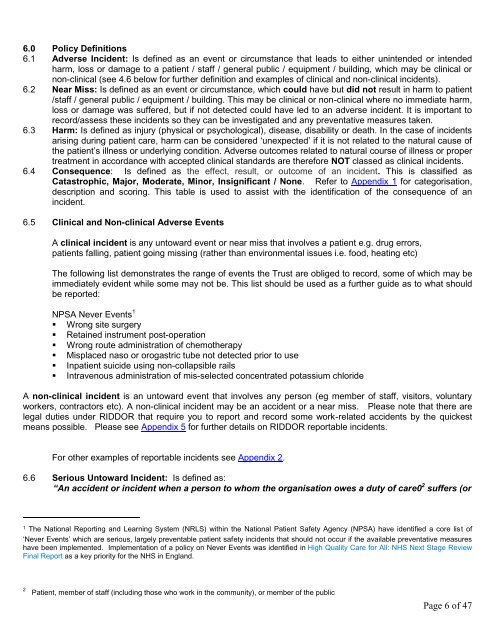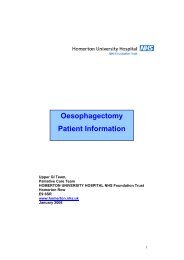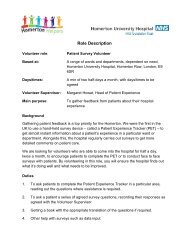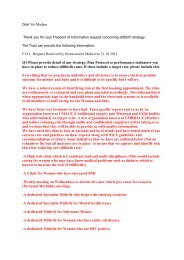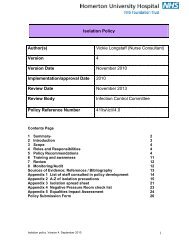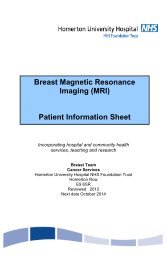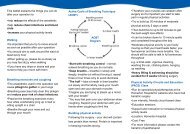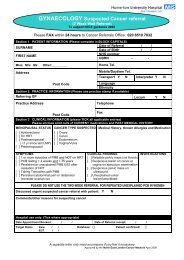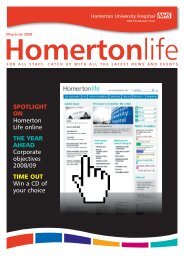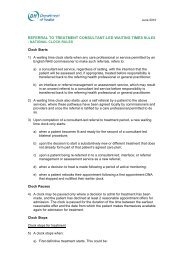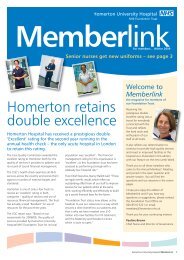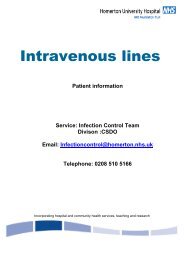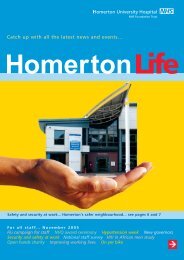Incident reporting policy - Homerton University Hospital
Incident reporting policy - Homerton University Hospital
Incident reporting policy - Homerton University Hospital
You also want an ePaper? Increase the reach of your titles
YUMPU automatically turns print PDFs into web optimized ePapers that Google loves.
6.0 Policy Definitions6.1 Adverse <strong>Incident</strong>: Is defined as an event or circumstance that leads to either unintended or intendedharm, loss or damage to a patient / staff / general public / equipment / building, which may be clinical ornon-clinical (see 4.6 below for further definition and examples of clinical and non-clinical incidents).6.2 Near Miss: Is defined as an event or circumstance, which could have but did not result in harm to patient/staff / general public / equipment / building. This may be clinical or non-clinical where no immediate harm,loss or damage was suffered, but if not detected could have led to an adverse incident. It is important torecord/assess these incidents so they can be investigated and any preventative measures taken.6.3 Harm: Is defined as injury (physical or psychological), disease, disability or death. In the case of incidentsarising during patient care, harm can be considered „unexpected‟ if it is not related to the natural cause ofthe patient‟s illness or underlying condition. Adverse outcomes related to natural course of illness or propertreatment in accordance with accepted clinical standards are therefore NOT classed as clinical incidents.6.4 Consequence: Is defined as the effect, result, or outcome of an incident. This is classified asCatastrophic, Major, Moderate, Minor, Insignificant / None. Refer to Appendix 1 for categorisation,description and scoring. This table is used to assist with the identification of the consequence of anincident.6.5 Clinical and Non-clinical Adverse EventsA clinical incident is any untoward event or near miss that involves a patient e.g. drug errors,patients falling, patient going missing (rather than environmental issues i.e. food, heating etc)The following list demonstrates the range of events the Trust are obliged to record, some of which may beimmediately evident while some may not be. This list should be used as a further guide as to what shouldbe reported:NPSA Never Events 1• Wrong site surgery• Retained instrument post-operation• Wrong route administration of chemotherapy• Misplaced naso or orogastric tube not detected prior to use• Inpatient suicide using non-collapsible rails• Intravenous administration of mis-selected concentrated potassium chlorideA non-clinical incident is an untoward event that involves any person (eg member of staff, visitors, voluntaryworkers, contractors etc). A non-clinical incident may be an accident or a near miss. Please note that there arelegal duties under RIDDOR that require you to report and record some work-related accidents by the quickestmeans possible. Please see Appendix 5 for further details on RIDDOR reportable incidents.For other examples of reportable incidents see Appendix 2.6.6 Serious Untoward <strong>Incident</strong>: Is defined as:“An accident or incident when a person to whom the organisation owes a duty of care0 2 suffers (or1The National Reporting and Learning System (NRLS) within the National Patient Safety Agency (NPSA) have identified a core list of„Never Events‟ which are serious, largely preventable patient safety incidents that should not occur if the available preventative measureshave been implemented. Implementation of a <strong>policy</strong> on Never Events was identified in High Quality Care for All: NHS Next Stage ReviewFinal Report as a key priority for the NHS in England.2Patient, member of staff (including those who work in the community), or member of the publicPage 6 of 47


